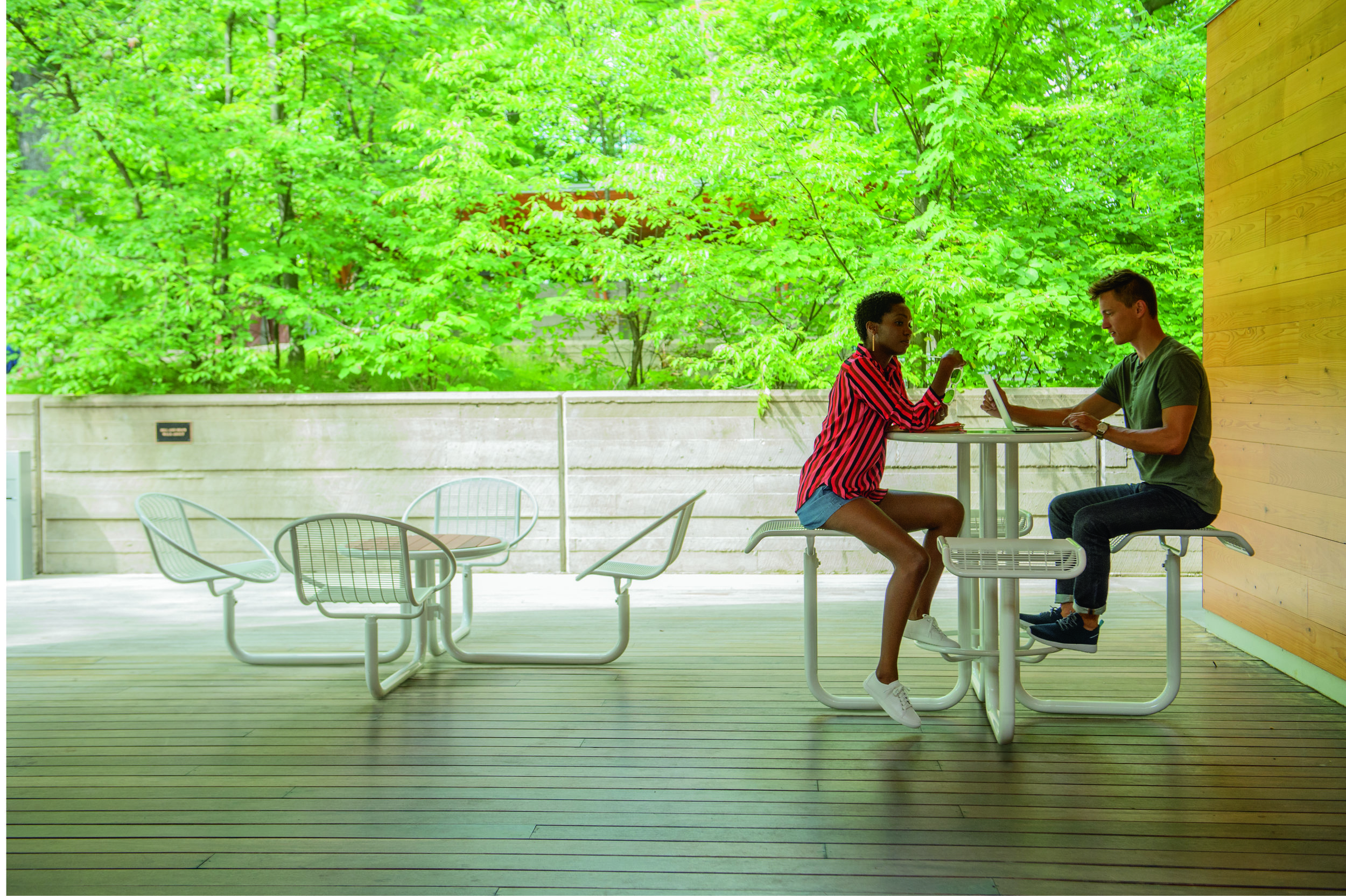Credit: Landscape Forms
by Jennie Morton
The next frontier for the office? Outdoors.
Businesses are starting to treat patios and courtyards as more than a landscaping area. These spots can be converted into a pleasant workspace for individuals, meetings and group collaboration. A natural setting can be a refreshing change of scenery that sparks a renewed sense of energy and drive.
An ode to the outdoors
Humans have an emotional response to nature. Sunshine can promote wakefulness, greenery can have a calming effect, and water features can lower stress. Workplace studies show employees are more productive when they have permission to move around within the office footprint. The reason people take their lunch outside, however, is to break away from the routine and rejuvenate their spirits. What if workers could experience those same benefits whenever they needed some mental clarity?
“Working outside provides employees with the opportunity of choice,” explains Joanna Frank, president and CEO for the Center for Active Design, which is the administrator of the Fitwell Certification System. “They can have a walking meeting, brainstorm in a relaxed setting and even have more candid conversations.”
Kirt Martin, vice president of marketing and design for the manufacturer Landscape Forms, likes to point out when people go on vacation, very few plan a trip that is exclusively indoors. He finds people have an “outdoor identity” with the places they live and visit, and that positive association can extend to where they work.
“Think about the old corner office — what did it have that made it so popular? Lots of windows with a view to outside,” Martin points out.
Many workplaces now place conference rooms and workstations along the perimeter instead of executive offices. And while access to natural scenery is a major improvement, it doesn't replace the benefits of working alfresco. These range from self-reported advantages like reduced anxiety, improved creativity and increased morale to measurable gains such as lower absenteeism, higher retention and decreased morbidity, Frank says.
“Working outside provides a physical separation as well as a mental break from the interior built environment,” explains Alvaro Ribeiro, senior architect at Margulies Perruzzi Architects. “For example, a simple boost in light levels has been shown to benefit our circadian rhythms and boost mood and energy levels. While a typical open office has a light intensity of between 30-50 foot-candles, one can experience approximately 10,000 foot-candles outside on a sunny day.”
Purposeful patios
Sticking a picnic table on a concrete pad and calling it an “outdoor workspace” won't have an impact on employee behavior anymore than placing ottomans in a group and calling it a “collaboration space.” Designing an exterior work area is more involved than furniture selection — it must be a true reflection of your company culture.
“You have to create spaces that truly work for people and serve them,” Martin says. “It needs to be purposeful and intentional. Start with defining what type of interaction you are trying to encourage. That affects the design.”
Franks stresses creating an area of respite and contemplation that is separate from the indoor hubbub. “Make it feel like a sanctuary.” he says.
At the Superior Court of California in Hollister the civic building includes health targets such as “improving the psychological health of employees.” Its design includes a private interior courtyard that allows staff to relax outdoors away from the public eye and participate in recreational and fitness activities.
For outdoor spaces to serve as a genuine amenity, your company leadership must also embrace having workers park outside for a spell. If employees worry supervisors think they are frittering away time, they will avoid the area altogether.
“You need to examine what is authentically appropriate to your business and its location,” Frank says. “Employees can easily spot meaningless gestures but will respond to sincerity.”
When National Development, a commercial real estate developer, renovated its 101 Station Drive location in Westwood, Maryland, the firm added an inviting plaza to this suburban office to encourage collaboration and relaxation.
“We worked with National to convey an inviting and compelling first impression,” Ribeiro notes. “The fireplace and soft seating recreates a setting more commonly found on an urban rooftop and allows for outside dining and casual seating. Grabbing the attention of a prospective tenant by locating this amenity right at the main entry adjacent to the cafe and fitness center is also an important statement.”
Partners Healthcare is a corporate campus in Somerville, Massachusetts. Open to 4,500 employees as well as visitors and guests, the nine-acre site includes outdoor spaces that invite people to sit down and linger. OJB Landscape Architecture “designed a landscape that inspires restorative experiences and alternately fosters employee and community engagement.” The company Landscape Forms provided many of the furnishings for the private roof deck and dining terrace, such as its Parc Centre chairs and tables, TUUCI umbrellas and Chipman chairs.
An outdoor workspace is one of the least expensive projects to design, Martin says. Its size depends on how large a company's workforce is and how much exterior space it wants to carve out for seating. It could be as large as a courtyard filled with umbrella tables to as modest as a deck with a few lounge chairs. Many businesses already have a small area that can be amplified with better furnishings.
“Just compare the average cost of an outdoor table to a standard conference table,” Martin says. “Plus that outdoor table is going to last so much longer, even in the elements.”
Eight essentials for open-air spaces
Whether it is time to refresh your outdoor space or create a work patio from scratch, here are eight considerations that should be integrated into the design.
1) Furnishing: “Use a variety of seating types and arrangements that accommodate different work activities, such as facing others, alone time, standing, sitting and pacing,” Ribeiro says.


